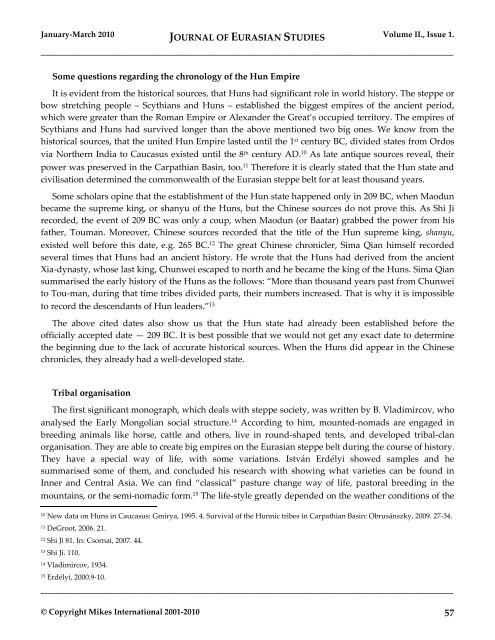EurasianStudies_0110..
EurasianStudies_0110..
EurasianStudies_0110..
Create successful ePaper yourself
Turn your PDF publications into a flip-book with our unique Google optimized e-Paper software.
January-March 2010 JOURNAL OF EURASIAN STUDIES Volume II., Issue 1.<br />
_____________________________________________________________________________________<br />
Some questions regarding the chronology of the Hun Empire<br />
It is evident from the historical sources, that Huns had significant role in world history. The steppe or<br />
bow stretching people – Scythians and Huns – established the biggest empires of the ancient period,<br />
which were greater than the Roman Empire or Alexander the Great’s occupied territory. The empires of<br />
Scythians and Huns had survived longer than the above mentioned two big ones. We know from the<br />
historical sources, that the united Hun Empire lasted until the 1 st century BC, divided states from Ordos<br />
via Northern India to Caucasus existed until the 8 th century AD. 10 As late antique sources reveal, their<br />
power was preserved in the Carpathian Basin, too. 11 Therefore it is clearly stated that the Hun state and<br />
civilisation determined the commonwealth of the Eurasian steppe belt for at least thousand years.<br />
Some scholars opine that the establishment of the Hun state happened only in 209 BC, when Maodun<br />
became the supreme king, or shanyu of the Huns, but the Chinese sources do not prove this. As Shi Ji<br />
recorded, the event of 209 BC was only a coup, when Maodun (or Baatar) grabbed the power from his<br />
father, Touman. Moreover, Chinese sources recorded that the title of the Hun supreme king, shanyu,<br />
existed well before this date, e.g. 265 BC. 12 The great Chinese chronicler, Sima Qian himself recorded<br />
several times that Huns had an ancient history. He wrote that the Huns had derived from the ancient<br />
Xia-dynasty, whose last king, Chunwei escaped to north and he became the king of the Huns. Sima Qian<br />
summarised the early history of the Huns as the follows: “More than thousand years past from Chunwei<br />
to Tou-man, during that time tribes divided parts, their numbers increased. That is why it is impossible<br />
to record the descendants of Hun leaders.” 13<br />
The above cited dates also show us that the Hun state had already been established before the<br />
officially accepted date — 209 BC. It is best possible that we would not get any exact date to determine<br />
the beginning due to the lack of accurate historical sources. When the Huns did appear in the Chinese<br />
chronicles, they already had a well-developed state.<br />
Tribal organisation<br />
The first significant monograph, which deals with steppe society, was written by B. Vladimircov, who<br />
analysed the Early Mongolian social structure. 14 According to him, mounted-nomads are engaged in<br />
breeding animals like horse, cattle and others, live in round-shaped tents, and developed tribal-clan<br />
organisation. They are able to create big empires on the Eurasian steppe belt during the course of history.<br />
They have a special way of life, with some variations. István Erdélyi showed samples and he<br />
summarised some of them, and concluded his research with showing what varieties can be found in<br />
Inner and Central Asia. We can find “classical” pasture change way of life, pastoral breeding in the<br />
mountains, or the semi-nomadic form. 15 The life-style greatly depended on the weather conditions of the<br />
10 New data on Huns in Caucasus: Gmirya, 1995. 4. Survival of the Hunnic tribes in Carpathian Basin: Obrusánszky, 2009. 27-34.<br />
11 DeGroot, 2006. 21.<br />
12 Shi Ji 81. In: Csornai, 2007. 44.<br />
13 Shi Ji. 110.<br />
14 Vladimircov, 1934.<br />
15 Erdélyi, 2000.9-10.<br />
_____________________________________________________________________________________<br />
© Copyright Mikes International 2001-2010 57

















